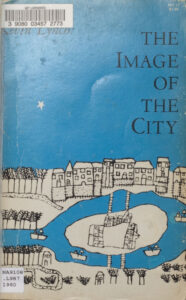 Published: Cambridge, Mass., 1960
Published: Cambridge, Mass., 1960
Could you direct a pedestrian from Post Office Square in downtown Boston to Myrtle Street on Beacon Hill? How about from Mass General Hospital to South Station? And could you describe what that pedestrian would see once they got there? As one part of his 1954-1959 “Perceptual Form of the City” study, Kevin Lynch sent researchers out into the streets of Boston to ask people to do just that. That study laid the groundwork for The Image of the City, Lynch’s seminal 1960 work on the urban environment.
Kevin Lynch studied at Yale University, Rennselaer Polytechnic Institute, and at Taliesin under Frank Lloyd Wright before earning his Bachelor’s degree in City Planning from MIT in 1947. He began lecturing in city planning at MIT the following year, became a full professor in 1963, and retired in 1978 to cofound the design firm Carr, Lynch, and Associates.
 In 1954, Lynch and Professor Gyorgy Kepes, working under the MIT Center for Urban and Regional Studies, received a grant from the Rockefeller Foundation to study city form. Their “Perceptual Form of the City” study explored 3 American cities – Boston, Jersey City, and Los Angeles – using two principal methods: they interviewed a small sample of residents regarding how they perceived their environment, and they systematically observed the “environmental image evoked in trained observers in the field.”
In 1954, Lynch and Professor Gyorgy Kepes, working under the MIT Center for Urban and Regional Studies, received a grant from the Rockefeller Foundation to study city form. Their “Perceptual Form of the City” study explored 3 American cities – Boston, Jersey City, and Los Angeles – using two principal methods: they interviewed a small sample of residents regarding how they perceived their environment, and they systematically observed the “environmental image evoked in trained observers in the field.”
The five-year study led to the publication of The Image of the City in 1960. The book considers what Lynch calls the “imageability” of the American city, or the quality which makes a city likely to evoke a strong image in an observer. Lynch argues for a “beautiful” city environment where the city’s various parts can easily be recognized by its inhabitants and organized into a coherent pattern. Such “legibility,” he contends, plays a crucial role in city planning.
In the first line of its preface, Lynch asserts that The Image of the City is a book “about the look of cities, and whether this look is of any importance, and whether it can be changed.” The continued influence of the work both at MIT and on architects and planners around the world – more than 50 years after it was originally published – affirmatively answers that query.
Lynch’s fingerprints are on the city designs in parts of Boston, Cleveland, Columbia, Md., Minneapolis, Los Angeles, San Francisco, and San Diego. His influence can also be seen in countless other designs by urban planners who studied his work. Lynch’s 1984 obituary in  the Boston Globe noted that The Image of the City has been called “the most influential 20th Century writing on the design of cities.”
the Boston Globe noted that The Image of the City has been called “the most influential 20th Century writing on the design of cities.”
The MIT Libraries own numerous copies of The Image of the City (including translations in German and Spanish). MIT’s Institute Archives and Special Collections hold the Kevin Lynch papers, which contain project documentation on the “Perceptual Form of the City” study. The Libraries hold nearly nearly 2,000 black and white photographs from the Boston portion of the study. The photos have been digitized and are available online, or as prints in the Libraries’ Rotch Visual Collections.
